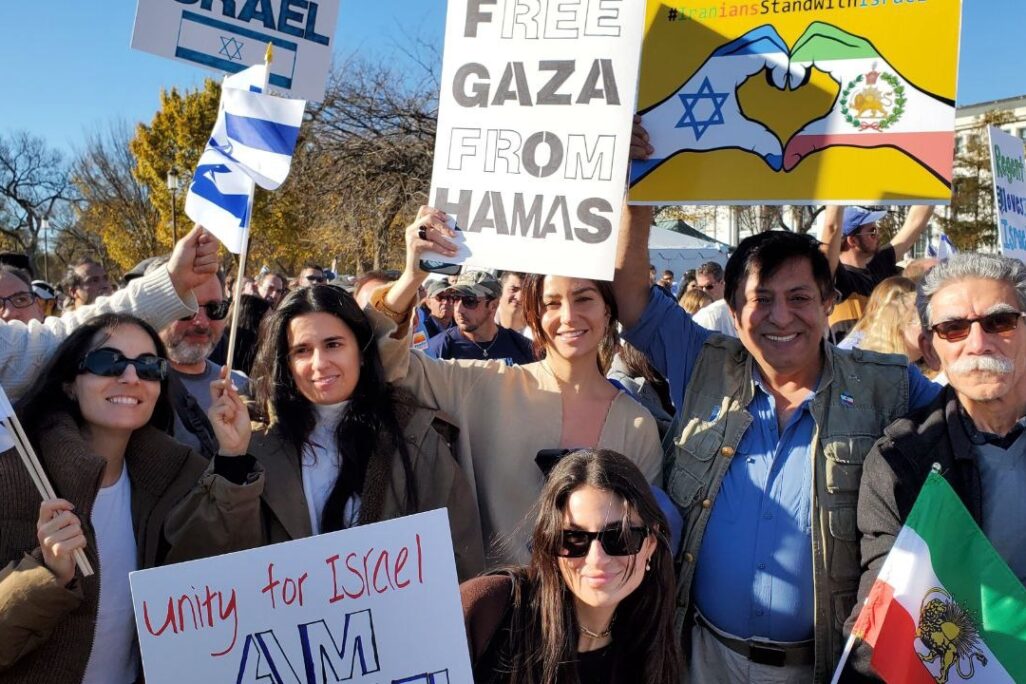
In the days after October 7th, Reza Farnood, a 60-year-old Iranian expatriate who lives in Washington DC, felt that it was entirely clear where he needed to be. Along with other Iranian expatriates, he showed up to the demonstration in support of Israel held in the city. He and his friends waved flags with the Lion and Sun, an ancient symbol that was used on Iranian flags until the 1979 Islamic Revolution.
"I called all my friends, and many of them came," Farnood tells Davar. "I have a friend who came specially from Florida to take part in the demonstration in Washington. But it wasn't to 'protect the Jews,' that's not the point at all. As far as I'm concerned, coming to the demonstration was a patriotic act, because these have been the true values of Iran for 3,000 years: 'We never ask what is your religion – we ask what is your name? Come and sit with us'. This is our heritage.
"What happened on October 7 was an attack against humanity," he adds. "How can you cut off a child's head, or burn a child, and call yourself a person? That's why I was moved to see our Lion and Sun flags at the demonstrations next to the flags of Israel. There was a very old man there, close to 90 years old, who grabbed me by the neck, hugged me tightly and kissed me and said to me, 'My son, my son, thank you for being here with us.' I felt like I was in my grandfather's arms."
Farnood is among the thousands of Iranians around the world, and even in Iran itself, who oppose the regime of the Ayatollah and dream of a free and democratic Iran. They consider the Israelis and the Jews, whom the Iranian regime incites against and threatens to destroy, as allies, and for them, the events of October 7th only strengthened the need to expand and strengthen their ties with Israel.
Many of them have participated in demonstrations in support of Israel in recent months across the US and Europe. It is important to them that Israelis know that the Iranian regime does not represent the entire Iranian people. They believe that they represent the original, historical spirit of Iran – of openness and religious tolerance.
"In order to bring peace, we need to get rid of the destructive government that rules Tehran today"
Farnood grew up in Iran in a mixed neighborhood. He remembers that on national holidays such as Nowruz, the Iranian New Year, everyone would celebrate together and congratulate each other. "I lived under the Iranian regime for 11 years. When the revolution started, I was a cadet in a military school. I saw that the Jews were being harassed, so my friends and I decided to patrol around the houses of the Jews to scare the revolutionaries. Someone asked us if we had received such an order, but there was no need."
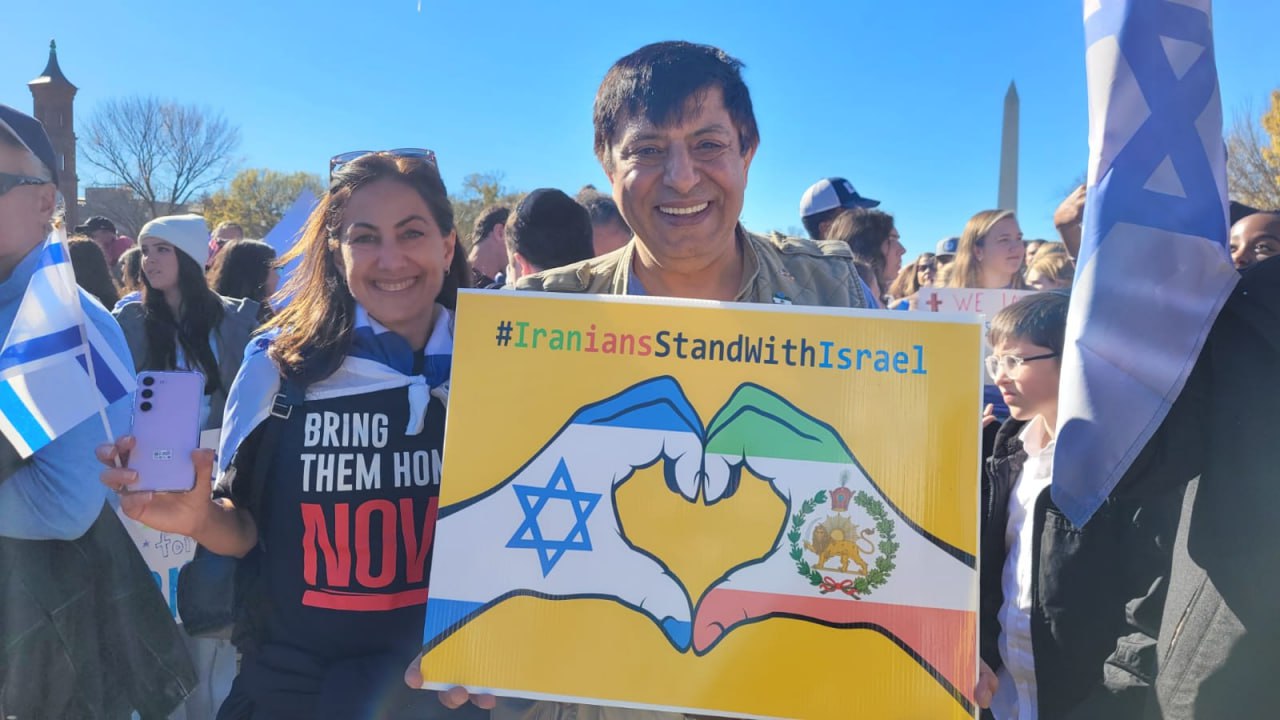
After that, when he worked in Tehran, he confronted the Islamic Revolutionary Guard Corps (IRGC) when he intervened in attempts to arrest women on the grounds of modesty offenses. Against this background, he was eventually forced to leave the country. "I have no fear in my bones. But my family did not allow me to stay there. Since I left I have not been in contact with my family, at least not in direct contact, for the sake of their safety. It must be remembered that most of the victims of this regime are not Jewish. Most of the people they imprisoned and murdered are Shia Muslims."
After witnessing the events of October 7, Farnoud realized that it would not be possible to bring peace to the Middle East without what he calls 'reviving the legacy of Cyrus the Great.'
"We Iranians fight for human rights and freedom of religion. When King Cyrus allowed the Jews to return to their country and build their temple, it was not a 'favor' he did for them. This is our belief as Iranians in freedom of belief, freedom of speech and peace."
Farnood says that he was moved last April when Reza Pahlavi, the former crown prince of Iran and the current Shah (Iranian king) in exile, visited Israel. Pahlavi, who works from abroad to promote human rights and democracy in Iran, participated in the Holocaust Remembrance Day ceremony at Yad Vashem, and even came to a condolence call at the home of the Dee family in Efrat after Lucy Dee and her daughters Maia and Rina were killed in a terror attack.
"I know Jews, and I know you don't like wars," says Farnood. "You fight because you have no choice. What Hamas did on October 7 was not intended to help the Palestinians return to their lands or build their lives. The goal was to delay the Abraham Accords, [and the attack was] funded and supported by the Islamic Republic. On October 7th, humanity lost to a group of terrorists. Therefore, the Iranians and the Israelis must unite, there is no other choice. In order to bring peace, we need to get rid of the destructive government that rules Tehran today."
"When I put the two women next to each other, I build the bridge between Iran and Israel"
On the front wall of the Museum of Tolerance in Jerusalem, a huge mural went up last January that expresses solidarity between Israeli women and Iranian women. It shows the image of Shirel Haim Pour, an Israeli soldier of Persian descent who was killed on October 7. Her likeness is composed from a mosaic of photos of victims of the October 7 attacks. Next to it is a picture of the young Iranian woman Mahsa Amini, who was murdered by the IRGC on the grounds that she 'didn't wear the hijab properly,' made up of pictures of other women who were murdered by the regime in Iran.
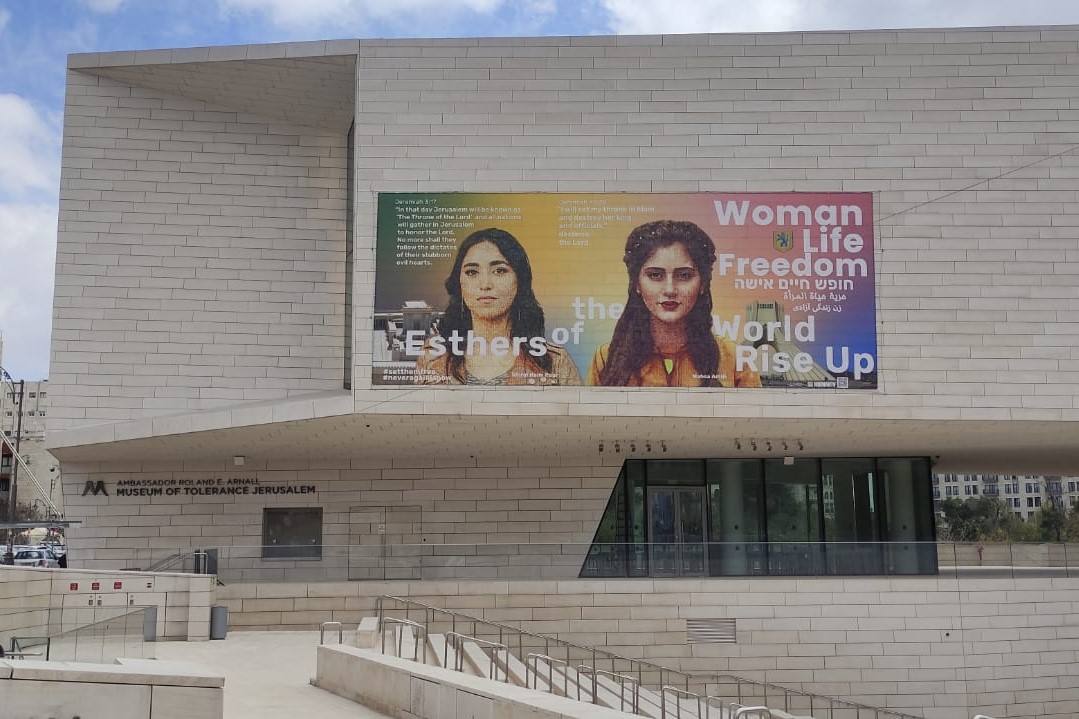
The mural was created by Hooman Khalili, an Iranian-American artist and radio broadcaster who lives in Los Angeles, California. For him, those murdered on October 7 in Israel are victims of the Iranian regime no less than the protesters who were murdered in Iran. "Shirel and Mahsa are two Persian women who were murdered by the Islamic regime," says Khalili. "Mahsa by the Revolutionary Guards, and Shiral by Hamas, which is just one arm of the octopus whose head is the regime in Iran today. This war is not only against Persian women in Iran, but against Persian women all over the world. And when I put these two women next to each other, I'm building the bridge between Iran and Israel."
The mural is a continuation of sorts of other works by Khalili that were displayed in Israel showing the faces of Iranian protesters who were murdered by the regime alongside the protest slogan 'Woman, Life, Freedom' in Hebrew, English, Arabic and Persian. In some of the works, he also included a slogan that is particularly relevant on the holiday of Purim: 'Esthers of the world – rise up.' He created the first work at the request of the Jerusalem Municipality, after being involved in an artistic solidarity project with the women's protest in Iran in 2022. After that he created other works in Nazareth, Netanya, Tel Aviv, Mevaseret Zion and Haifa. These days Khalili is raising funds to create more works which he wants to spread all over Israel.
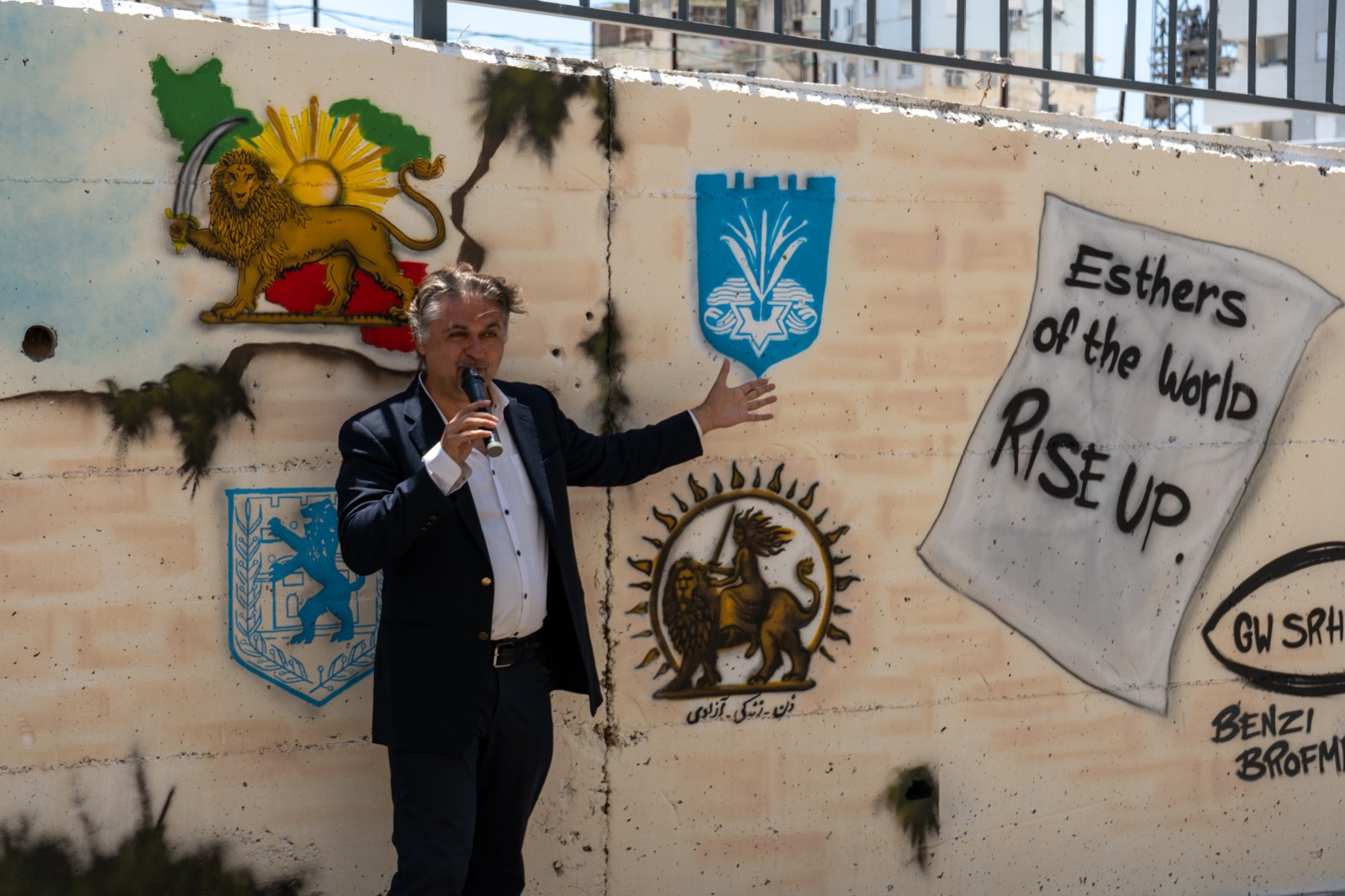
Khalili's works in Israel led to a reaction from the Iranian regime, which he says shows that they also understand the potential of solidarity between Israelis and Iranians. "It was amazing," he says, "they didn't feel the need to respond to the murals I created all over the world, but after the murals in Israel also appeared on Iranian television, they put up 30 huge murals of atomic bombs around Tehran with the caption '400 seconds from Tel Aviv.' When it happened, I realized how important my work was in Israel, and how frightening it was to the regime. This is the best way to fight antisemitism and disinformation about Israel."
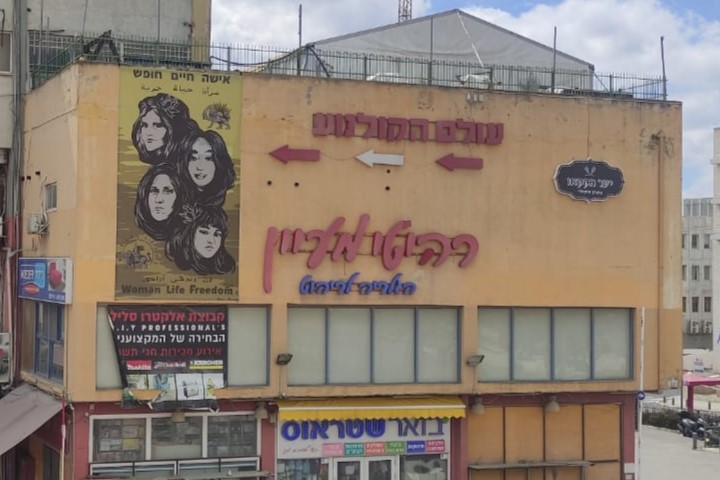
Khalili also saw his works’ ability to raise awareness within his own social circles. "When I first arrived in Israel to start the project, an Iranian friend from Los Angeles called me and started yelling at me: 'What are you doing in Israel? Get out of there! I hate them.' I told her I was busy, but I promised to call her back after I put up the mural and let her yell at me for an hour. And after we put the work up in Talpiot [in Jerusalem], I called her and told her, 'You can yell at me now if you want.'
"There was a long silence, and then she said to me, 'I can't believe how beautiful this work is. I can't believe that the Jews stand together with the women of Iran. It's hard for me to believe that the Israelis love the Iranians. It confuses me so much… Why was I so angry? I apologize for yelling at you.' This story repeats itself with every work I create in Israel."
"I am a real Iranian"
Reza Aghaei, from Strasbourg, France, hung the Israeli flag in the living room of his house, next to what he considers the 'real' flag of Iran, which bears the symbol of the Lion and Sun. "I've had many arguments with people here in France," he says. "People don't understand what kind of enemy Israel is facing. I've heard people explain that Hamas is a 'resistance movement' and not a terrorist organization. What kind of resistance movement does such terrible things? As someone who has seen what Islamic Sharia rule looks like, I understand what Islamic terrorism is, and understand that it must be opposed."
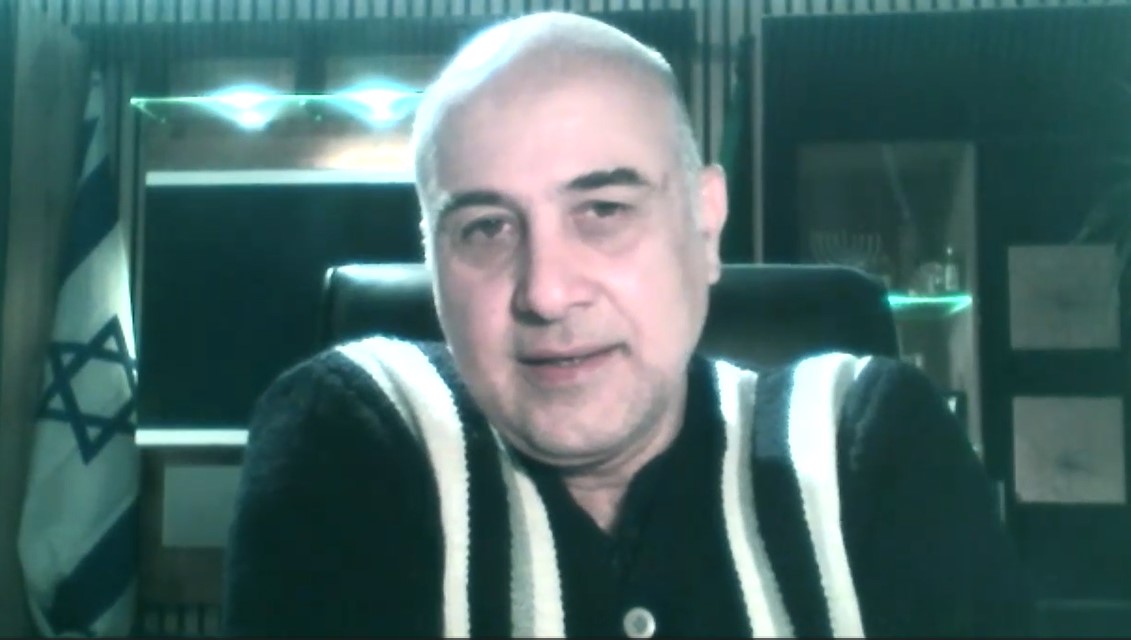
"When people see that I have an Israeli flag at home, they react with astonishment. They think that Iranians hate Israel. But I am a real Iranian, not a man of the Islamic Republic, but the Iran of Cyrus the Great and Xerxes. It's just like on Purim: Haman, who wanted to kill the Jews, was not a Persian. And today, the Islamic Republic is not really Iran. It is not only opposed to Israel, but also opposed to our Iranian culture. Opposed to the Nowruz holiday that we celebrate this week, and opposed to our thousand-year-old traditions."
"Ties between Israelis and Iranians are the greatest fear of the Islamic regime"
Iranian support for Israel also comes from within Iran itself. Korush, who lives in Tehran, has worked for many years to provide the Iranian public with reliable and positive information about Jews and Israel. He was interviewed by Davar without revealing his full name, for fear of his safety.
His connection to Israel is a family connection and a personal one. "My mother could not conceive due to a medical complication she had after an abortion," he says. "In 1978 she went to Israel for medical treatment, and with the help of doctors at the Hadassah Hospital in Jerusalem, she was able to conceive again, and I was born in Tehran. Therefore, I feel that I owe the State of Israel my life. My parents always told me how beautiful Israel is, and about the sense of hospitality they experienced there."
In 2010 he founded the Israel-Iran Peoples Friendship Association. "Of course, we cannot act openly, because any contact with Israel from inside Iran carries the risk of execution. But we were able to register in the United States as a non-profit organization, for the purpose of fundraising. Our main goal is information and the fight against antisemitism inside Iran, because we believe that in order to create friendship between nations, we need to deal with the rumors and lies that the Islamic government spreads against Jews and Israel, and spread the facts."
The association operates a page in Farsi on the social network X (formerly known as Twitter) with more than 11,000 followers. "We publish materials about Jewish culture, the history of the relationship between the nations, Israeli technology, the geography of Israel, and more. Many people send us messages and thank us for distributing this information." According to the Iranian government-owned Mehr News Agency, 88% of Iranians have access to the Internet.
From Korush's point of view, the Iranian public for the most part does not hate Israel and the Jews. "Despite the government's efforts, antisemitism and hostility towards Israel did not really take hold in Iranian society," he says. "Even after the events of October 7, when the regime tried to encourage demonstrations in support of the Palestinians, they failed to organize large demonstrations here, unlike other places in the Muslim world.
"I think ties between Israelis and Iranians are the biggest fear of the Islamic government here, which is our common enemy. This tie is our heritage. Cyrus the Great was the first Zionist in history when he allowed the Jews to return to Israel from the Babylonian exile. We, his sons, should continue in his footsteps."
"Iranian friends told me, 'We are ready to come to Israel and enlist'"
From his home in Jerusalem, Dr. Daniel Dana works to bring closer relations between Israel and the Jewish people and the Iranian people and to promote social change in Iran that will lead to the overthrow of the Ayatollah’s regime. "For 45 years, the regime of the Islamic Revolution has been spreading lies and propaganda against the State of Israel," he says, "but the Iranian public today understands that this regime is working against them, and therefore, everything the regime says actually creates the opposite effect in the hearts of Iranians. If the regime says that Israel is terrible and needs to be destroyed, people only want to learn more about Israel, get more excited about it and love it more.
"Unfortunately, in Iran itself today there is no overt pro-Israeli activity, but underground there are definitely groups that support Israel, and I am also in contact with some of them," says Dana. "I am in contact with a lot of Iranian communities in the diaspora, and a lot of people know me personally. After October 7, hundreds of Iranian friends called me to tell me 'we are ready to come to Israel to enlist, to fight alongside you on the battlefield against the terrorists from Hamas.' They understand that the people of the Islamic Republic are the head of the snake. One of them, a young man, came here on his own accord from the United States, paid for a ticket, for a hotel and simply came and reported, and appealed to the government to recruit him."
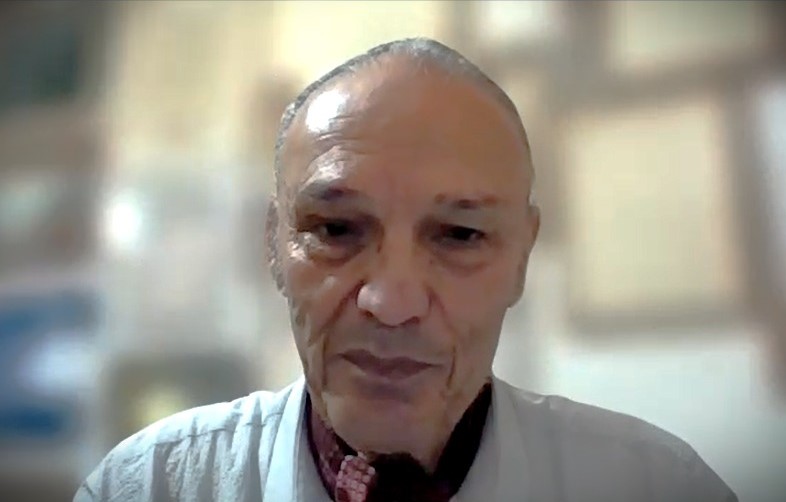
Dr. Dana's unique life story expresses the possible bridge between the Iranian people and the Jewish people. He was born Jamshid Hasani to a Shia Muslim family in the north of Iran, and in his youth studied religion with the goal of becoming a Shia cleric. However, in his adulthood he became a secular jurist, and during his studies In Paris he was among the first Iranians to demonstrate against Ayatollah Khomeini, six months before the Islamic Revolution, when Khomeini visited the city and gathered support.
A few weeks after the outbreak of the revolution, Dana went to Morocco and met with the Shah's wife, Farah Diba Pahlavi, and suggested to her that he return to Iran with the aim of assassinating Khomeini. But she dissuaded him from this course of action, and ordered him to gather loyal Iranians in Europe. Upon his return to Paris, he established a semi-military underground organization of Iranian exiles opposed to the revolutionary regime. At the height of the underground's activity, in 1981, it managed to hijack an Iranian missile ship that left a port in France for Iran, an operation in which Dana personally participated. On the third anniversary of the revolution, the underground bombed the foundations of a large mosque that the Iranian regime had begun to build in Paris at the site where Khomeini had lived before the revolution..
Although he had three death sentences from the courts of the Islamic Revolution hanging over his head, Dana decided to return to Iran in 1987, where he worked as a lawyer representing political prisoners and women sentenced to death by stoning by the government. Two years later he had to flee once more, this time to Australia, where he received political asylum.
The twists and turns of his life path led him to become a Christian and to start studying to be a teacher in addition to his legal career. Dana also began another subversive endeavor: translating Salman Rushdie’s The Satanic Verses, which is highly critical of the Iranian regime, into Farsi. This drew the attention of Australian intelligence services, who feared for his life and ordered him to stop.
In 1994, Dana visited Israel as part of a scholarship he received for research in the field of international law in collaboration with experts from the Hebrew University of Jerusalem. It was supposed to be a visit of several weeks, but the Australian intelligence services took the opportunity of his departure from the country to cancel his refugee status and declare him persona non grata, forbidding him to return. He was forced to stay in Israel.
Dana decided to tie his life to the Jewish people, and began a conversion process. But then the most surprising thing happened. In 2000, he was diagnosed with thalassemia anemia, a rare blood disease, and the doctor at Shaare Zedek Hospital explained to him that it is common among Jews of Middle Eastern origin. "I was surprised," he says, "after all, I am a member of a Muslim family from Iran."
But a little later, when he visited his cousin in the United States, she told him that her father confessed to her on his deathbed that their family was a Jewish family that had been forced to convert and hide their Jewishness following a pogrom against the Jews of the Iranian city of Mashhad in 1839. "Suddenly I understood why my Shiite grandmother used to separate meat from milk. Fate brought me to Israel and led me to stay here, to understand who I am."
"If Israel is the only democracy in the Middle East, why shouldn't Iran be the second?"
Dana explains that the relationship between the Jewish people and the Iranian people is 2,700 years old. "There is documentation of economic and commercial relations with the Median kingdom [which was centered in modern-day Iran during the 7th century BCE and preceded the Persian Achaemenid Empire]. The peak was during the reign of Cyrus the Great, who allowed the Jews to return to Zion from the Babylonian exile and to build the Second Temple, as described in the Book of Ezra. After that is the story of Purim, Esther and Mordechai, in the days of Xerxes."
Dr. Dana claims that even during the rebellion of the Maccabees, Jews and Persians fought a common Hellenistic-Greek enemy, and that there is evidence of cooperation between Jewish and Iranian groups in the struggle against imperial Rome.
"During the 500 years of Islamization of Iran, Iranian Jewry suffered, as did the original Zoroastrian culture of Iran, which was repressed. In the 1920s, Shah Reza Pahlavi came to power, who promoted religious tolerance and improved the situation of the Jews in Iran. His son, Shah Mohammad Reza Pahlavi, was the first Muslim leader to recognize the State of Israel in 1950."
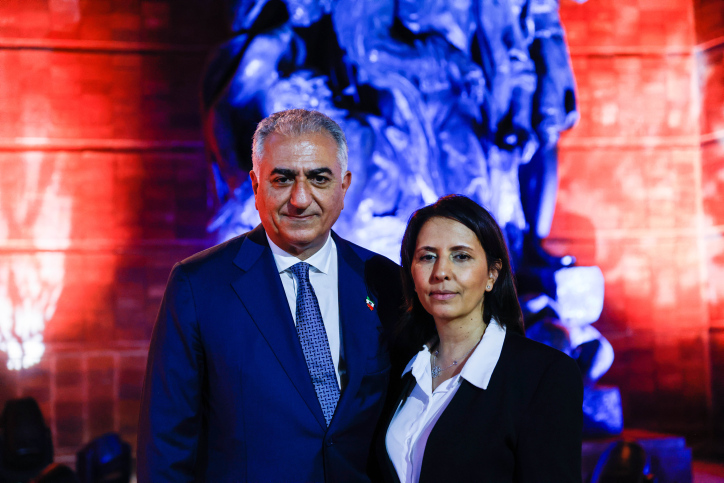
For Dana, the struggle against the current Iranian government coincides with the promotion of friendship between Iranians and Israel. "I believe that the overthrow of the regime in Iran is approaching," he says. "The majority of the public in Iran wants to overthrow the regime of the Ayatollahs, but lacks the weapons and the tools. We must help them, support them and give them tools. These two great cultures of the Middle East should join hands. If Israel is the only democracy in the Middle East today, why shouldn't Iran be the second? I am very optimistic. The hostile relations between Israel and the Arab world in general are changing in the direction of peace.
"Iran, which is the largest country in the region, with about 85 million citizens and another 15 million citizens in diaspora, can complete the Abraham Accords. These relations are right economically, strategically and diplomatically. This is our heritage, and we want to develop it, study it and explore it. If after the Six Day War the Shah had to hide his relations with Israel because of the hostility in the Arab world, this time we must shout this relationship from all the rooftops of Iran and open this story to the whole world, saying that we are brotherly peoples who must march together towards a better Middle East."
"There is a pro-Israeli wave in Iran, we must reach out to them"
Tom Wegner, strategic consultant and CEO of Wegner Strategy and Public Relations, has identified in recent years a great thirst on the part of Iranians for contact with Israelis. Wegner, who was previously the spokesman for the Peres Center for Peace, has been engaged for many years in promoting relations between Israel and Israelis and the Arab and Muslim world.
"Today you can see on social media in Iran an open discourse of people who identify with Israel, using profiles under pseudonyms, and describing a very significant pro-Israel wave in Iran itself," says Wegner. "There are very clear reasons for this: the public there is completely separated from the regime, and in a relationship so hostile towards it, that if the regime says that Israel is bad, the public will say: 'We know you are liars, so Israel is probably good.' There is such a strong alienation between the public and the regime, that I don't think is recognized in the world – people celebrate in the streets the loss of the national soccer team, because the feeling is that it was the regime's team that lost and not the people's."
Wegner says that after October 7, the hashtag "Iranians Stand With Israel" reached huge proportions. Along with the participation of the Iranian communities in the diaspora in pro-Israel demonstrations, he says, the sentiment among the residents of Iran also strengthened. "In many ways, this pro-Israeli wave is literally cutting the branch on which the Iranian regime sits. This is something that needs to be strengthened and embraced – this extended hand must not remain empty. We must reach out to them. The truth is that I feel that even on our side it is a very encouraging experience to see this wave of sympathy, after the feeling that we are hated as Israelis from all directions."
Recently, the Peoples Friendship Association responded to an initiative of Israel’s Ministry of Diaspora Affairs with the aim of developing dialogue between Israelis and Iranians. "Today, in the age of social media and especially after the COVID-19 pandemic, when we all understood that you can have even complex conversations over Zoom and WhatsApp, it’s much simpler," Wegner says. "All that’s left is perhaps bridging the language gap, and today there are also tools for automatic translation that make communication much easier."
Wegner calls on Israelis to start talking to Iranians. "Anyone on their social networks can connect to pages such as the page of the Israeli Ministry of Foreign Affairs in Farsi, and start communicating with those who comment there. There is a group we opened on Facebook, and hopefully in the near future we will create more tools such as groups and pages that will organize this communication.
"Our voices as Israelis give our partners in the Iranian opposition the opportunity to show the Iranian public that Israel has nothing against the Iranian people, beyond the regime's threats. Along with this, there must be a dialogue between leaders, intellectuals, cultural figures, which can lead to musical, cultural, political and business collaborations."
This article was translated from Hebrew by Nancye Kochen.






